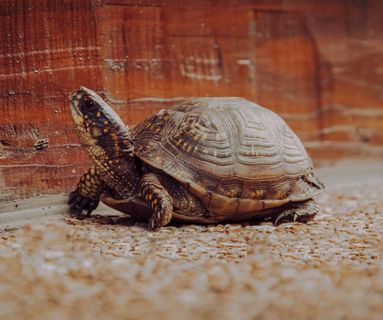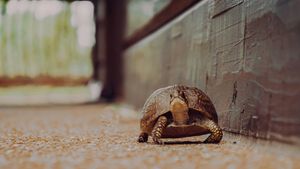
Eastern Box Turtle, Florida Box Turtle, 3-Toed Box Turtle, Ornate Box Turtle, Desert Box Turtle
Terrapene sp.
Adult Size: 25-50 years
Captive Lifespan: 30-60 years
Indoors: 4’ x 2’ tortoise table, Waterland Tubs terrestrial habitat, Zoo Med Tortoise House; avoid glass terraria
Outdoors: Minimum 4’ x 4’ predator proof outdoor enclosure
Indoors: Cypress Mulch, Chipped Coconut Husk
Outdoors: Topsoil , grass
Avoid: gravel, sand, cedar chips, pine shavings, aspen shavings
Establish a temperature gradient within the enclosure with heat lamps with a warm end of 85-90 degrees F and a cool end no cooler than 70 degrees F.

UVB lighting is required for proper calcium metabolism. Use either fluorescent (tube or "spiral" bulbs) or mercury vapor bulbs designed specifically for use in reptiles. Follow manufacturer’s recommendations for use, installation, and replacement frequency.
Box turtles are omnivores; feed a diet approximately 50/50 plants and insects; can also offer gel mixes such as those manufactured by Repashy Superfoods.
Insects/Protein: Earthworms, mealworms, black soldier fly larvae, hornworms, crickets, slugs, and snails. Can offer small amounts of low fat canned cat food on occasion.
Plant Material: Dark leafy greens, dandelions, carrots, squashes, pumpkin, apples, strawberries, tomatoes, raspberries, blueberries, bell peppers, edible mushrooms, etc.
Avoid: Iceberg lettuce, onions, garlic

Indoor box turtles should be supplemented with a calcium carbonate powder and a multivitamin containing true Vitamin A twice weekly.
Fresh water should be provided at all times.
Indoors: Provide multiple hide boxes throughout the enclosure. One should be set up as a “humid hide” with moist sphagnum moss or similar substrates to provide a humid microenvironment for shell health.
Outdoors: Provide an artificial burrow and edible bushes and shrubs
Droppings should be removed as soon as possible. Disinfect the enclosure regularly using either Rescue brand disinfectant or a mixture of 1 tablespoon bleach to 1 cup of water, make sure to rinse thoroughly after. Bowls should be disinfected at least weekly. The water area should be filtered using a fish tank or pond filter. Turtles are messier pets than fish so it’s best to choose a filter rated at least twice as big as the volume of water in the enclosure.
Copyright © All Rights Reserved
